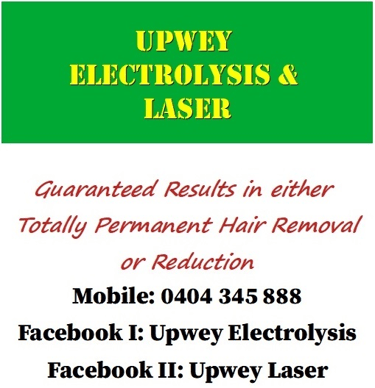Laser Hair Removal (LHR)
I have become a passionate therapist due to my past experience as a client for electrolysis, laser & IPL hair removal. I had got epidermal burn once from IPL hair removal resulting in severe burn, followed by hypopigmentation in that area for about 5 years without any hair reduction result from that overtreatment.
For any light therapies including diode, IPL & laser hair removal, I think not only therapists but also clients need to be well informed about it before deciding to have the treatment. I had got skin burn from IPL hair removal because back then I didn’t know how I should have felt during and straight after the procedure as my therapist had never provided any consultation!
Therefore, every customer should read and understand the following information before they start laser (diode, or IPL) hair removal treatment. To achieve the most successful result you could possibly get, compliance is required from both therapists and clients, especially timing between treatment sessions.
Expectation:
Provided you are a good candidate for LHR and strictly follow our instructions, laser can provide long term hair reduction. This means that in most cases the majority of hair will not return after a series of treatment. This course of treatment varies from person to person, but will usually be about 4 – 6 sessions possibly about a month to three months apart followed by some maintenance treatments. Majority of your hair is going to disappear forever and stop growing after the initial course of treatments of around 4 to 6 sessions, with any residual hair growth being finer, softer, lighter in colour and re-growing at a dramatically slower rate. This residual hair growth can be left alone, treated by electrolysis or you can have occasional laser maintenance treatments, which can vary from a few months apart to once every 4-6 years. The degree of hair loss and the time taken to get results will vary from person to person as there are many factors that can influence hair growth.
In order to achieve maximum result of greater hair reduction, you need to follow the initial course strictly as recommended by us. It is recommended that your initial first two treatment sessions are:
around 8 weeks apart for facial areas &
around 10 - 12 weeks apart for other parts of body,
then your subsequent third to sixth sessions are no longer than 3 to 6 months apart. Or as soon as the majority of your hair start emerging from the skin, please resume the LHR treatment as soon as possible. You must strictly follow this instruction, click here!
If you want to achieve completely and permanently “gone forever” removal of every single unwanted hair, electrolysis is the only solution.
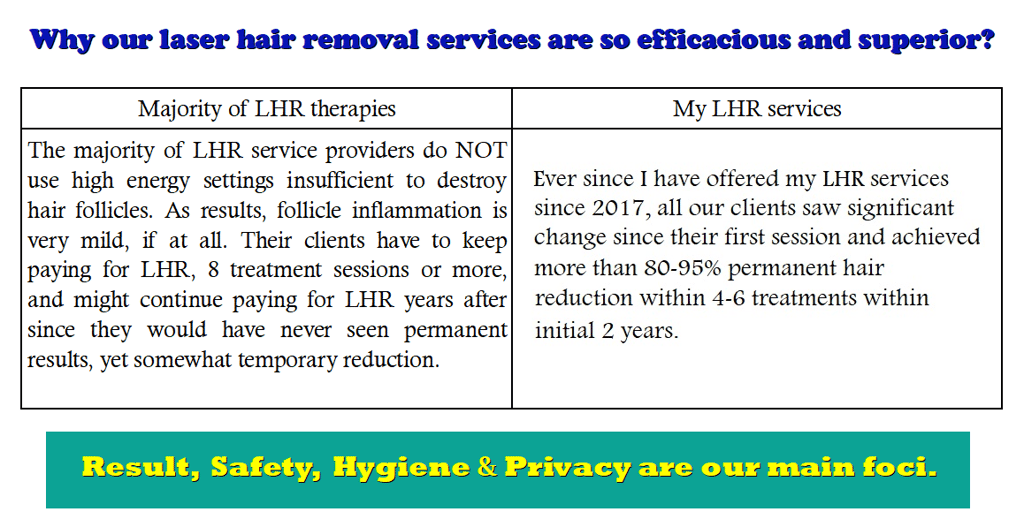

Why settings and being very thorough right from the start are so vital for your ultimate results?
Virtually all current light-based therapies for hair removal lose efficacy when hair become spare and light. Therefore, to achieve greater ultimate hair reduction results, therapists must:
1. Use high energy settings to sufficiently raise the temperature to fully coagulate the hair FOLLICLES and that temperature is above 75 °C just like when egg white starts to change from fresh clear liquid to cooked cloudy solidified. So how can customers feel painless if the treatment is meant for efficacy? This requires machines with higher power outputs in order to be able to produce higher fluence (J/cm2) & shorter pulse duration/width (in millisecond [ms]). Exposure to too many treatment sessions and/or low energy settings can stimulate growth of more vellus hair.
Light therapies such as laser, IPL, diode can stimulate more hair growth if too low settings and too many laser treatment sessions are used. So you have to find therapists who use high energy settings and can guarantee of at least 85% or greater permanent hair reduction within 4-6 treatments.
2. Therapists must be very thorough and this takes time even when super powerful LHR machines with high output powers are used. Thus this takes time, not a quick procedure. Clients achieve greater permanent hair reduction when their initial, virgin hair is still super coarse, dense & dark. LHR become less effective and fails after successive treatment sessions. That is the reason why it is very important to find the right therapists with right machines/devices right from the start.
The Differences Between Laser Hair Removal and Electrology:
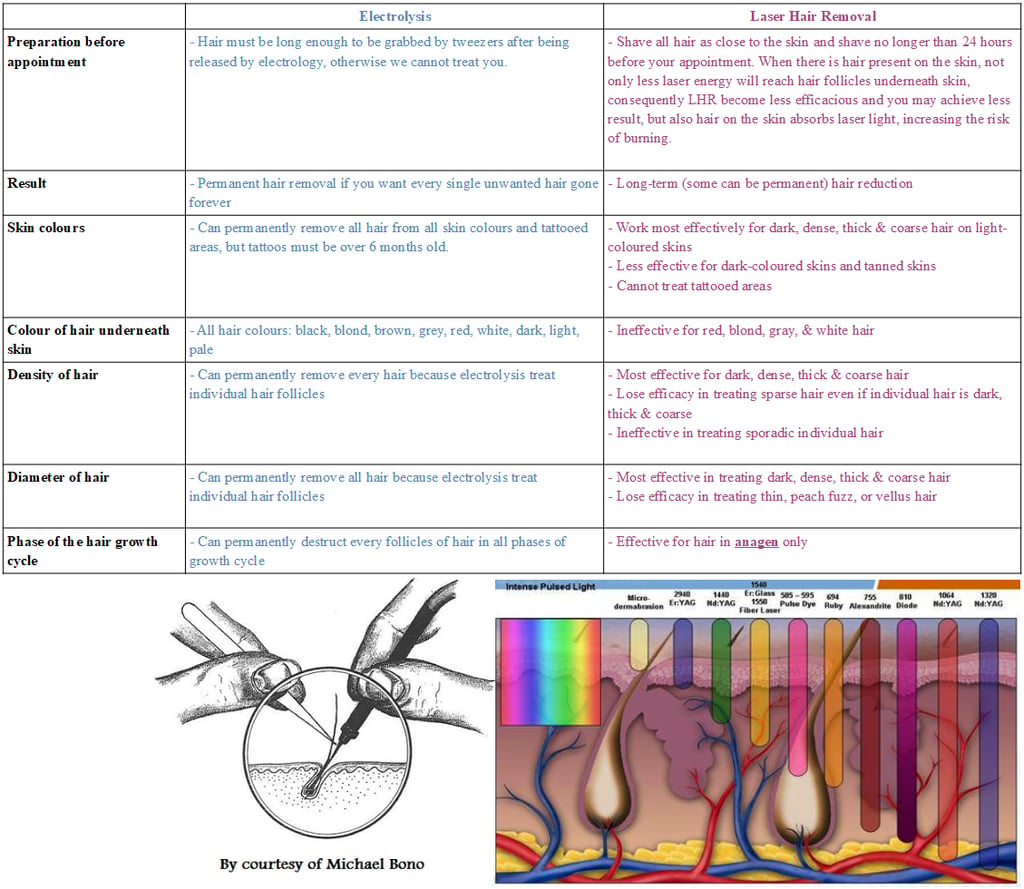

Electrolysis
- Hair must be long enough to be grabbed by tweezers after being released by electrology, otherwise we cannot treat you.
- Permanent hair removal if you want every single unwanted hair gone forever
- can permanently remove all hair from all skin colours and tattooed areas, but tattoos must be over 6 months old.
- All hair colours: black, blond, brown, grey, red, white, dark, light, pale
- can permanently remove every hair because electrolysis treat individual follicles
- can permanently remove all hair because electrolysis treat individual follicles
- can permanently destruct every follicles of hair in all growth phase cycle
Laser Hair Removal
- Shave all hairs as close to the skin and shave no longer than 24 hours before your appointment. When there is hair present on the skin, not only less laser energy will reach hair follicles underneath the skin, consequently LHR become less efficacious and you may achieve less result, but also hair on the skin absorbs laser light, increasing risk of burning.
- Long-term (some can be permanent) hair reduction
- Work most effectively for dark, dense, thick & coarse hair on light-coloured skins
- Less effective for dark-coloured skins and tanned skins
- Cannot treat tattooed areas
- Ineffective for red, blond, gray and white hair
- Most effective for dark, dense, thick & coarse hair
- Lose efficacy in treating sparse hair even if individual hair is dark, thick & coarse
- Ineffective in treating sporadic individual hair
- Most effective in treating dark, dense, thick & coarse hair
- Lose efficacy in treating thin, peach fuzz, or vellus hair
- Effective for hair in anagen only
Preparation before appointment:
Result:
Skin colour:
Colour of hair underneath skin:
Density of hair:
Diameter of hair:
Phase of the hair growth cycle:
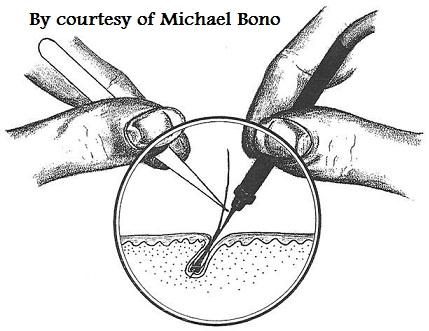

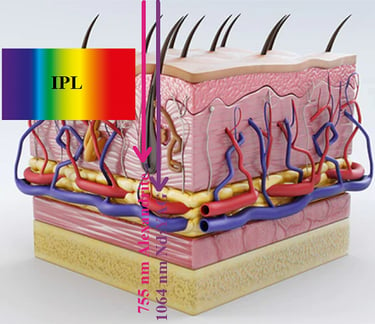

Why your age is important to your result?
On average, full pattern of hair growth should be completely developed after around mid 20's for female and mid 30's for male. This means a young client who still have to go through puberty may require more sessions and/or may spend longer time than a fully-grown adult on average.
There is no age restriction for laser & electrolysis hair removal but the client must has the maturity to demonstrate that he/she understand the treatment process, what is expected of the procedure, preparation before each treatment session & aftercare.
The benefits & risks of laser & electrolysis hair removal are the same for younger people as they are for adults.
The main decision to do laser or electrolysis hair removal needs to come from the clients themselves, not their parents or guardians. This must be something the young clients want for themselves and not because their parents want them to have it done.
However, for a client under the age of 18 years old, the presence of a legal guardian on the first consultation and written consent from a legal guardian are required.


To achieve greater reduction results from LHR:
Before coming to the apptmt =>
Before booking & coming for each LHR appointment:
1. For ultimate, optimal results of greater hair reduction, wait around 6 - 8 weeks (not earlier and not later) after waxing, plucking, threading, epilation cream or other methods that affect/disturb/weaken hair underneath the skin, before having LHR.
To ensure ultimate uttermost reduction result from LHR, it is recommended to WAX around 6-8 weeks prior to the appointment, expecting ALL hair that emerging out of your skin post waxing are in anagen.
2. Here, we do NOT treat clients with recently sun exposure, tanned skin or fake tan. Allow tan to fade prior to treatment. When in doubt, compare treatment area with limited sun exposure area such as your bum.
Other businesses can treat tan skin because they use low settings to lower risks of over treatments such as burn. But this will ruin clients' ultimate results to have the uttermost hair reduction in the long run.
3. Avoid any laser treatments when your skin is still inflamed or sensitive, such as from recently exfoliation, chemical peeling and etc.
4. Please shave no longer than 24 hrs before the appointment. Shave as close to the skin as you can for better results. Please do not injure your skin when shaving. Inflamed, injured, wounded skin posts risk for over-treatment and cannot be treated until it heals.
Do NOT use shaving cream or any other chemicals that affect/disturb/weaken hair, such as Nair, Veet and other hair removal creams/chemicals.
5. You must have your skin clean & free from moisturiser, make-up, deodorant, perfume & etc. before the appointment and at least 48 hrs after the treatment.
Dust, dirt, natural tanning, artificial tanning, hair, cosmetic, make-up products or even residuals may contain colours darkening the surface of the skin. When the surface of the skin darkens, more laser energy will be absorbed by the skin's surface rather than by the underneath hair – our main target. When too much light energy is absorbed at the skin surface, not only it posts higher risk for over-treatment, such as blister and burn, but also less result in hair reduction.
The skin should be free from any of coloured products, pigments and residuals before each treatment. Any residual dark pigments on skin can cause severe burn.
If the surrounding skin is lighter than the colour of the hair, the energy of the laser is concentrated mainly in the hair shaft, effectively destroying it without much affecting the skin.
If the skin contains dark pigments, both skin & hair will absorb laser light, thus less heat concentration in the hair.
The less pigment in the skin and the more darker pigment in the hair, the better result.
6. Please wear clean & loose clothing for area u wish to be treated. Natural fabrics, such as cotton and linen are more preferred. Avoid anything that can create friction or heat over treated areas, such as chafing fabrics.
7. Please inform us of pregnancy and any other changes of your health condition and medications
when booking and before the procedure.
This includes any changes of herbals, supplements, vitamins, substances, and prescribed & over-the-counter medications,
ingested, topical, injected, inhaled and etc.
Please also inform us if you have any allergies.
You must disclose your medical circumstances to us before using our services. We are not liable for any medical and health issues that have not made known to us by the customer.
8. Do not bleach hair.
9. When you should avoid LHR.
Laser hair removal isn't for everyone.
(The list is not meant to be exhaustive but is a good starting point for issues that are contraindicated for LHR.)
• individuals who can't stay out of the sun
• body dysmorphic disorder
• history of skin cancer, such as melanoma
• raised moles, suspicious lesions, hypertrophic/keloid scar formation, healing problems, active infections, open lesions, wounds, open skin, hives, herpetic lesions, cold sores, autoimmune diseases such as lupus, psoriasis, scleroderma or vitiligo
• Stop using any topical products containing benzoyl peroxide, glycolic/salicylic acids, AHA, alcohols, witch hazel, astringents, vitamin A and its derivatives, such as retinoids (for ex, over-the-counter retinol and prescribed stronger tretinoin (Retin A), Tazorac, or etc. for at least 7 days before and after the LHR treatment.
• cold sensitivity including Raynaud phenomenon
• Individuals with a known history of frequent Herpes Simplex Virus (HSV) 1 or 2 lesions should begin prophylaxis prior to treatment as prescribed by their physician. Clients are advised to take the antiviral medications (examples: acyclovir or valacyclovir) at least one day before and continue after each treatment session strictly as directed until you finish the prescription, even if you feel better. If you stop taking medication too soon or skip doses, your infection may not be completely treated or may become more tolerant and difficult to treat.
• Photosensitivity can be induced by your genetic inheritance and/or certain substances.
In the present & in the last 6 months, have you been using the following substances? (Click here to see non-exhaustive list.)
The list are examples of photosensitising/photosensitive substances that can induce photosensitivity and can make your skin sensitive to light including laser light and sunlight.
These substances are some medications, herbals, supplements, vitamins and/or cosmetic products (either via ingestion, topical application, inhalation and/or injection) you are currently using and/or you have been using within the last 6 months.
Exposure to light, these medication may induce hyper-, hypo-pigmentation, dermatitis, blister or burn.
LHR can be performed when clients stay off such medication for at least its 1/2 life or longer when it is out of their body system.
Clients are advised to consult their medical doctors before stopping their medications.
Clients are also advised to stay off such medication 7 days after each light-based therapy.
• Hydroquinone, skin brightener, skin lightening or bleaching agent – Stay off them for at least 7 days prior to and after each LHR due to higher risk of pigmentation complications.
• Pregnancy, trying to get pregnant, or during breastfeeding
• Seizure disorders including light-triggered seizures
• Intramuscular gold therapy
• Individuals who r currently taking anticoagulants, blood thinners, iron supplements, herbal supplements such as ginkgo, ginseng or garlic may bruise more readily.
• Individuals with implanted medical devices such as Pacemakers, cardioverters, and other implantable devices or fillers, please consult your physician.
• For clients with sensitive skin and histamine, or have a history of allergy, hay fever, asthma, eczema, prolonged erythema or edema, taking oral anti-histamine 1 hours before & 48-72 hrs after laser treatment is optionally recommended. Prescribed topical corticosteroids may also be another option. Click here for possible adverse effects of corticosteroid creams.
• Avoid any heating devices including LHR 2 weeks prior to or after Botox.
• Avoid laser treatments at least 2-4 weeks or longer prior to or after filler. Consult with your provider for their specific recommendations.
Electrolysis is the only solution for permanent hair removal for individuals with the following cases:
• blond, red, grey and white hair
• sparse, thin hairs or individual/isolated/patchy coarse hair
• tattooed sites & permanent makeup
If you have any concern or questions, you are more than welcome to contact us.
Sun Issues
-- Laser is attracted to any dark colours. Hair under the skin needs to be sufficiently dark for LHR treatment to be effective, but if there are any dark colours in the skin there can be complications as the light will possibly be absorbed by it.
-- Some skins may be too dark for safe treatment, as the light can be attracted by dark colour present in the skin. Thus much lower energy is used & therefore less effectiveness in outcomes.
-- Sun exposure is also a potential problem as the light will be attracted by the newly formed melanin in the skin causing burn, hyper or hypo pigmentation & some other complications. We recommend you avoid sun exposure for at least 4 to 8 weeks pre and post treatment. At all other times use at least SPF 35+ & PA+++ sunscreen.
-- If you are having hair removal treatment on the hands, wear cotton gloves when driving, gardening or playing outdoor sports.
-- A SPF 35+ sunblock should be applied if there is any likelihood of sun exposure, however significant sun exposure & tanning must be avoided pre-, post- treatment & during the course of laser treatment.
-- Mineral or physical sunscreens (such as those containing non-nano zinc oxide or titanium dioxide as main ingredient) are better than those containing other chemicals or organic compounds. The reason is that mineral sunscreens act similarly to aluminum foil reflecting sunlight, blocking it from entering into our skin, whereas other sunscreens allow light to absorb/enter into our skin. Additionally, zinc is anti-inflammatory & anti-microbial.
Examples of Case Studies for Non-Compliance
Case 1: LHR on recent tanned skin
The client came to the laser clinic with her skin looking normal. There were no obvious signs shown on skin from recent sun exposure prior to LHR procedure. Who was to blame, the therapist or the client?
Had the therapist seen any signs, the therapist wouldn’t have treated the client until after the client’s skin had healed and tan had faded.
Remember! straight after sun exposure, you won't see any signs and your skin can still look normal until after a day or two post-sun exposure. It can take a day or 2 after sun exposure for your skin to show any damaged signs, such as redness, tanning, blistering, peeling and/or sun burn.
Case 2: Post Inflammatory Hyperpigmentation (PIH) because the client sunbathed 2 weeks (too early) after LHR
Source: the medical textbook “Laser Hair Removal” by David J Goldberg, M.D. 2000 ISBN: 1 85317 831 4
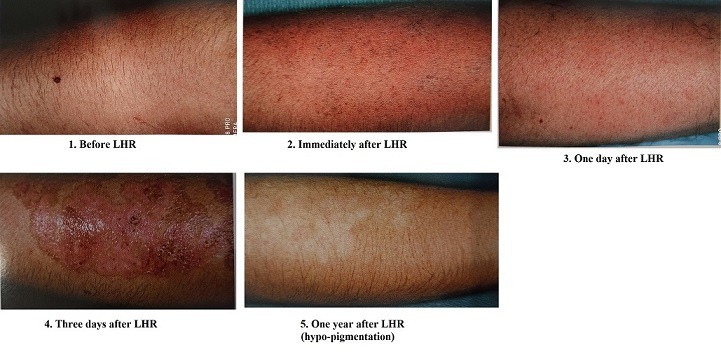

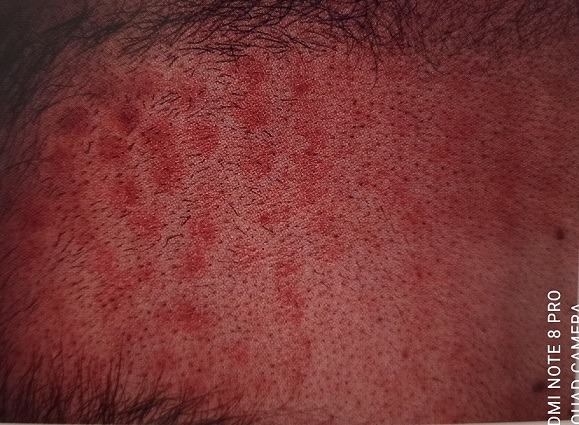

During the LHR procedure:
1. When light beam hitting your skin, you will feel like a hot rubber-band snap, stinging sensation, and/or needling hotness through your hair follicles, without any lingering pain or heat. But the sensation will cease as soon as the laser pulses stop firing. Your skin should cool down almost immediately. If it feels extremely hot and is not cooling down, you MUST alert your therapist immediately. The heat & pain should go away almost immediately as soon as the pulse stopped & moved away from that treated spot. Any lingering pain or burning sensation can result in blisters and/or burn.
Your skin won't immediately show the signs of overtreatment, which can take some time from few hours to longer post treatment.
IF YOU THINK YOU ARE BURNT OR OVER TREATED, or you feel lingering heat and/or pain that doesn't go away, ask your therapist to COLD compress you IMMEDIATELY for at least 20 minutes or longer.
(Be aware that ICE compression can cause freeze burn. Thus, if iced pack is used ensure to keep removing it from the same skin area every few minutes and/or wrapped the iced pack with disposable kitchen paper towel such that it does not have direct contact with your skin.)
2. Once you done, you will get red bumps all over but it is only temporary and will disappear after a day or two.
Because treated follicles have been heated, the area may become red and possibly swell for up to a day or longer in certain area. Swelling results from heat, not infection, and is therefore normal and expected.
Crusts or scabs can occasionally form in some spots. Again, this does not mean infection and does not mean the area will scar. Do not pick the scabs, as this can lead to scarring. Allow them to fall off naturally. This is nature's way of healing.
Some clients especially with skin colours of Fitzpatrick Type III and darker might hyperpigmentation. But this is temporary and gradually fades away over time. Hyperpigmentation is NOT a sign of over treatment, but it means that your follicles have been destroyed and this is how your skin normally heals.
3. For clients with sensitive histamine, such as those with history of hay fever, eczema and etc., inflammation of hair follicles may last longer and heal slower.
4. Now that you've been lasered, you must put on lots of sunscreen all over the treated area to avoid pigmentation.
5. Hair should gradually fall out within a week or two after treatment. Although this may appear to be hair growth at first, it is not. This process is called purging or shedding and will take time to complete. You can exfoliate with a clean loofah or sponge once the sensitivity of treated area resolves. Start this exfoliating process 1 week after treatment, but no earlier. Exfoliation helps speed up the process of hair growth.
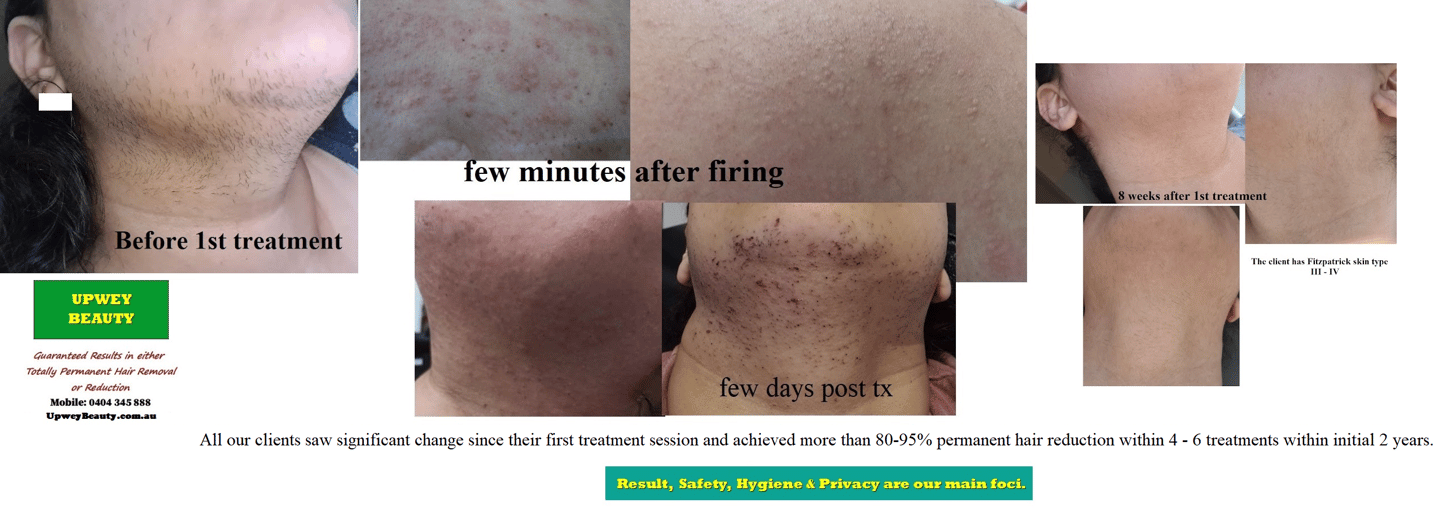

Clinical endpoint indicating effective laser hair removal: perifollicular oedema or inflammation of hair follicles, showing damage of hair follicles
Aftercare Instructions
-- Apply a cool compress to relieve swelling or warm sensations, 1-2 hours after treatment if needed.
-- If you experience intense itching for a few days after treatment, applications of clean cold pack, non-alcohol-containing aloe vera gel, Sudocrem, antiseptic cream will help. Sometimes over-the-counter oral antihistamines will help relieve itching.
-- Avoid any activities and sources of friction and/or heat such as exercise, too warm shower, spa/sauna and etc. for first 48 hrs after treatment. Do not wear tight clothing, clothing with zips that may rub on the treated area. Do not use anything that can bring heat to the skin, for example electric blankets.
-- Cold or Lukewarm shower (& Avoid HOT showers/baths) for first 48 hours after treatment.
-- Pat dry after showering, but do not pick or rub the treated areas.
-- Do not go in a spa/pool/sauna or anywhere that involves chlorine/chemicals or excessive heat/sweating for 48 hours after treatment. No bathing (Cold or Lukewarm Shower is ok) for first 48 hours after treatment. Do not go swimming in pool or open water for 48 hrs to avoid exposure to chemicals, pathogens & etc.
-- Avoid the gym or excessive sweating/exercise for 48 hours after treatment. Avoid friction on treatment site and anything that raises body temperature for 48 hours.
-- If possible, do not apply makeup for at least 48 hours after LHR.
If being bare skin isn't possible, tinted mineral or physical sunscreens (especially those containing non-nano zinc oxide as main ingredient) can be used as concealers. This type of sunscreens is better than those containing other chemicals or organic compounds. The reason is that mineral sunscreens reflect sunlight, blocking it from entering into our skin, whereas other sunscreens allow light to absorb/enter into our skin and we don't want this to happen, right? Additionally, zinc is anti-inflammatory & anti-microbial.
-- Do not scratch, pick or rub the area. Scratching or picking will have the same result as picking any scab or pimple, and the area could scar.
-- In between LHR treatment sessions, don't use any other methods and products that affect, weaken, soften or disturb hair underneath the skin. Also do not wax, pluck, thread, and do not do anything that can disturb hair underneath the skin. Doing these will ruin your ultimate results in achieving greater hair reduction in the long run.
-- You can shave as often as you like, & you must shave no longer than 24 hrs before each appointment. Do not use shaving creams that soften or disturb hair underneath the skin.
-- Do not apply any irritants to your treated area, such as any topical/skincare products containing benzoyl peroxide, glycolic/salicylic acids, AHA, alcohols, witch hazel, astringents, vitamin A and its derivatives, such as retinoids (like over-the-counter retinol and prescribed stronger tretinoin (Retin A), Tazorac, or etc. for at least 7 days before and after the LHR treatment.
-- Wear protective clothing or sunscreen (SPF 35+) to protect the treated area from direct sun exposure. Be sure to reapply sunblock throughout the day. It is imperative to the success of future treatments and skin health to protect the skin from sun exposure while undergoing LHR treatments. No sun exposure on the area you wish to be treated for at least 4-6 weeks before and at least 4 weeks after each treatment.
Hair should gradually fall out within a week or two post LHR treatment.
But it has been 2 weeks now, why my hair doesn't fall out?
Case 1: If some hair fell out and some not, so it looks patchy now. This is because not all hair was in anagen when you were having LHR treatment, provided that your therapist was extremely thorough and no missed patches/no areas left untreated.
Case 2: If not much change and not much hair fell out at all,
2.1 energy settings might be too low (some machines, definitely NOT our machine, have too low power, beyond their capacities to emit energy insufficient to destroy hair follicles.) More effective high settings are higher fluence (J/cm2) & shorter pulse duration/width (in millisecond [ms]). Using too long pulse duration is counterproductive.
2.2 Therapist was too rushing in providing treatment, spending insufficient time to heat each hair follicles by moving laser handpiece too fast and causing lots of missed patches.
Case 3: If not much change and not much hair fell out at all, laser hair removal is NOT effective for you because your hair is either blond, red, grey, white, too light in colours, sparse, thin, fine or vellus.
When to book your next LHR appointment?
For LHR, timing between each appointment is essential, not only to help obtain the best result for long-term greater hair reduction, but also to minimise hypertrichosis risks. Your 1st & 2nd sessions should be between 6 to 12 weeks apart. Then subsequent 3rd to 6th session should be between 6 weeks to 6 months apart.
Since laser, diode, & IPL works effectively for hair only in anagen. When to resume next LHR treatment session? Not too early while more density of hair is still required & not too late when hair grow out too long - hair may no longer be in anagen phase of hair growth cycle. These can ruin your ultimate result to have the uttermost reduction. Resume next appointment as soon as majority of your hair start emerging out from skin. Good time to have next treatment is when majority of hair is in anagen, that is week 2 or week 3 after when you see the need to shave your hair, only then you will get the greatest ultimate reduction result. In other words, resume your next LHR treatment around week 2-3 after when you see majority of your hair starts emerging from your skin.
The most effective result is when the majority of your hairs are in the anagen phase. Why?
Any dark-colour objects (in this case, dark melanin in skin cells & hair shafts of all growth cycle including anagen) absorb light from laser and turn the light into heat and give off such heat to surroundings that have no dark pigments, such as colourless follicles containing colorless hair stem cells and other growth factors. Any colourless, red, blond, grey & white objects don't absorb light produced by any current LHR devices.
Only hairs in anagen phase are still in contact with the parts of colourless hair follicles containing colourless stem cells. Even though hairs in other growth phases absorb light from laser and give off heat to surrounding but they have lost contact with stem cells. If the stem cells aren't destructed, hairs will eventually grow back.
The subsequent LHR session, the less the result. Click here for explanation.
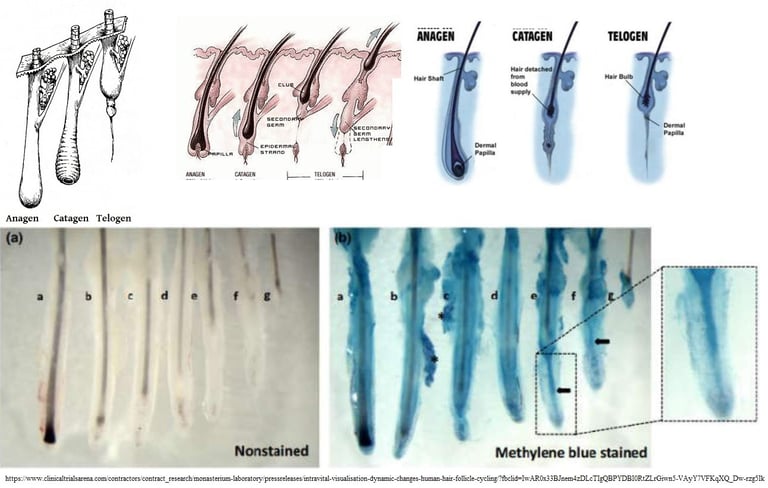

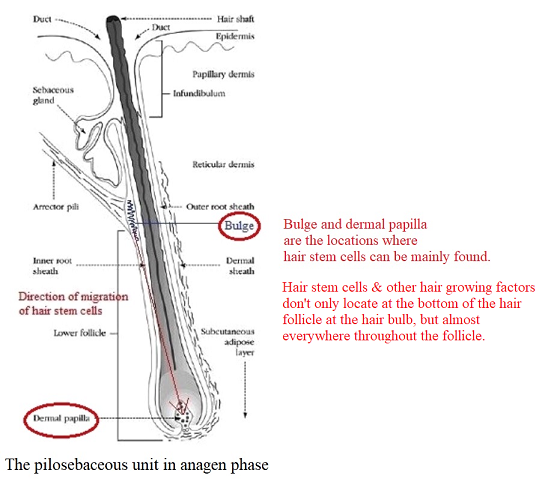

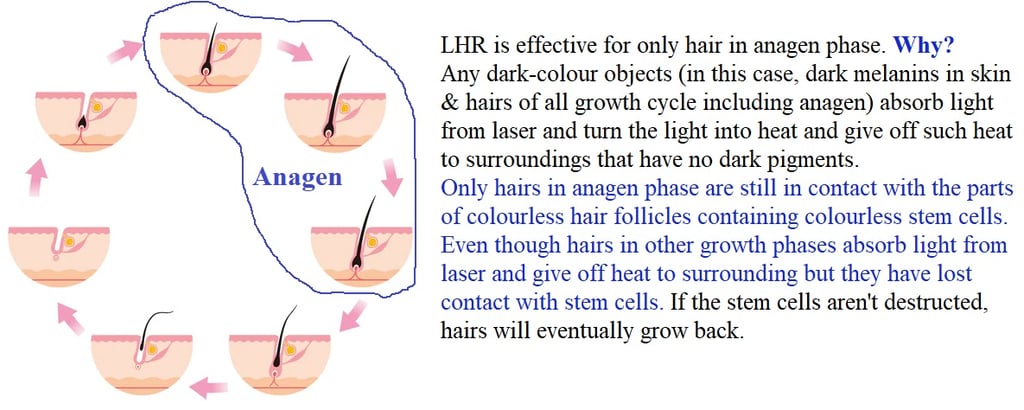

When to resume next LHR treatment?
You canNOT decide when to have your next treatment session for laser hair removal, let your hair dictate you when it's the time to do this!
Answer: "when majority of your hair is in anagen"
Not following the program regarding timing of treatments will reduce efficacy of LHR treatment and will significantly negatively affect your ultimate result.
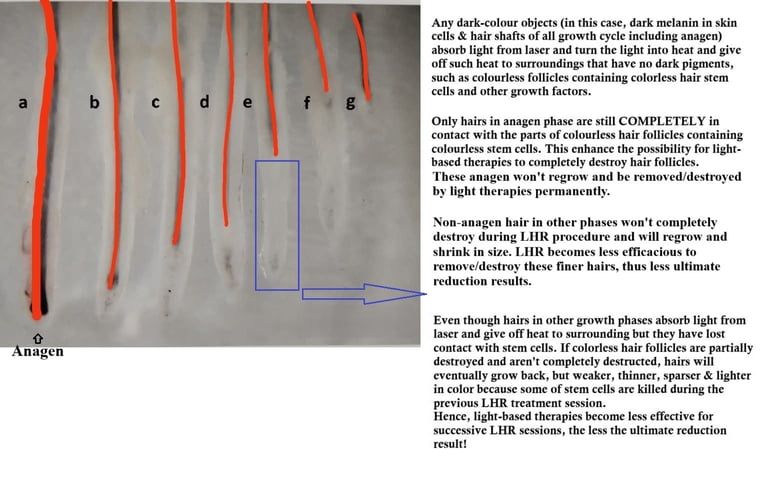

When should you cease having LHR?
You must experience ALL of the following events every single time you are having LHR done:
Your hair follicles become inflammed (red angry bumps) 10-15 mins after they are hit by laser beams.
Your hair fall out/shed within 1-2 weeks after the treatment.
If you do NOT experience these 2 events, stop wasting your money and cease laser, diode or IPL hair removal. Electrolysis becomes your only choice that can permanently destroy every hair.
Myth 1: The combination of Radio Frequency (RF) and IPL can permanently remove white, grey, blonde and red hair.
Myth 2: Using long-pulsed wavelength of around 532nm emitted by IPL or crystal lasers to permanently remove white, gray, blonde and red hair by targeting blood supplies to the hair follicles immediately after waxing
Fact: no real evidence so far
Evidences: There have been these combined IPL + RF tech devices for around at least 15 yrs, obsolete eLight & elōs by Syneron (renowned Candela) as for examples. Additionally, the treatment techniques of waxing hair and then immediately treating vascular supplies to the hair have been around for longer than a decade. They still can't deliver permanency for removing these hair colors. Some therapists reported (anecdotal evidence) that these techniques can retard hair growth, but electrology is still the only permanent solution for white, grey, red and blonde hair.
As a customer, how to ensure that you don't fall for these deceiving marketing traps? Have you achieved the actual results that:
Significant hair reduction after one single treatment
Your hair grows at a dramatically slower rate after 2 treatments
The worst-case scenario: 3 months after 4 treatments, your hair must be at least 70% reduced & less than 30% remains. Otherwise change therapist, change laser clinic or light-based therapy isn't effective for you. If you don't, you may end up with more hair stimulated by laser, IPL, diode, LED, LLLT & other optical therapies.
You have achieved at least 85-95% hair reduction within 4-6 treatments and no further additional hair removal methods, such as shaving, are required and you are at least 80%-95% hair free for at least 4-6 years or forever after your last treatment????
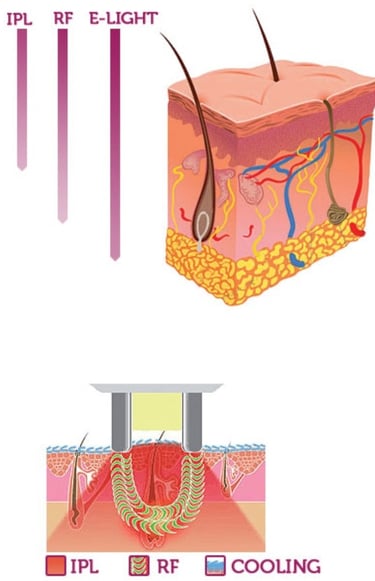

Paradoxical Hypertrichosis Associated with Laser and Light Therapy
The risk of hair stimulation is higher when:
– Under-treatment using insufficient fluence and energy settings
There are studies showing evidences that treatment series of low levels or low doses of light therapy (LLLT & LED) significantly increase hair stem cells, reversed the miniaturisation process of the hair follicles and stimulated hair growth.
– Colour, diameter & density of hair is too light or too sparse
Avoid having any LHR treatments over area where there is no hair or where there is vellus, fine hair in order to minimise the hypertrichosis risk. Light therapies can turn fine, vellus hairs into coarse terminal ones.
– Too early or waiting far too long between each treatment session
Timing is essential, not only to obtain the best reduction result but also to minimise hypertrichosis risk. Good time to have treatment is when majority of hair is in anagen, only then u will get the most ultimate reduction result. Thus as soon as significant percentage of hair starts emerging out of your skin, this is a good time to resume treatment. Do not resume the next treatment too early when hair isn't dense enough or do not wait until your hair is too long because these can ruin your ultimate result.
*** Insufficient customer compliance with our guidelines is a common reason for suboptimal laser hair removal results in the long run. ***
